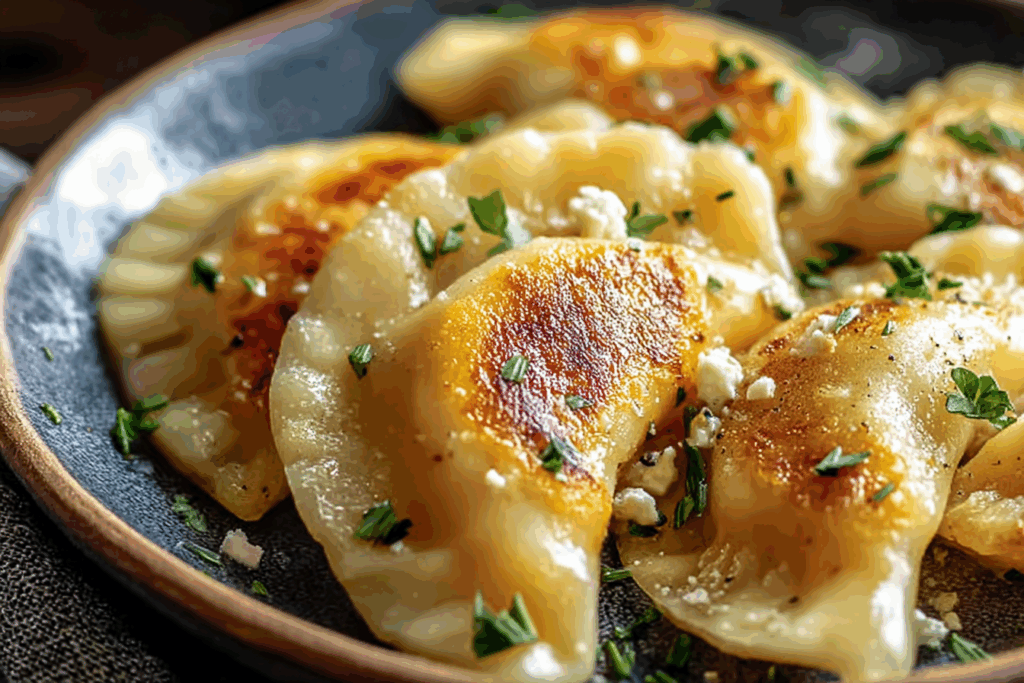There’s something magical about the moment a golden pierogi hits the pan, sizzling gently in butter until its edges turn crisp and caramelized. Now imagine that same pierogi filled with sweet roasted butternut squash and salty, tangy feta cheese. The creamy, savory filling tucked inside a tender dough creates the kind of comfort that feels like a warm hug on a chilly day. Trust me, this Roasted Butternut Squash Feta Pierogi recipe is worth every bite.
Behind the Recipe
This recipe was inspired by cozy fall evenings spent in my grandmother’s kitchen, where pierogi dough was rolled out by hand and laughter filled the air. I decided to give her traditional potato version a twist by adding roasted butternut squash and feta for a creamy yet bright flavor. It’s a little nostalgic, a little modern, and completely irresistible.
Recipe Origin or Trivia
Pierogi have deep roots in Central and Eastern European cuisine, most famously associated with Poland. Traditionally filled with potatoes, sauerkraut, or cheese, these dumplings were once peasant food, made from humble pantry ingredients. Today, pierogi are enjoyed around the world, with endless creative fillings. The combination of butternut squash and feta adds a Mediterranean flair to this beloved classic.
Why You’ll Love Roasted Butternut Squash Feta Pierogi
Versatile: You can serve them as a main dish, a side, or even freeze them for later.
Budget-Friendly: Uses simple, seasonal ingredients that stretch beautifully.
Quick and Easy: The dough comes together fast, and the filling can be made ahead.
Customizable: Try adding caramelized onions or spinach to the filling for a fun twist.
Crowd-Pleasing: Everyone loves a plate of warm, golden pierogi.
Make-Ahead Friendly: Prepare and freeze them, then cook straight from frozen.
Great for Leftovers: Reheat them in a skillet with butter for a quick, crispy snack.
Chef’s Pro Tips for Perfect Results
Before we dive into making these golden beauties, here are a few tips to help you nail them every time:
- Let the roasted squash cool before mixing with feta so the cheese keeps its texture.
- Roll the dough thin but not too thin — about 1/8 inch gives the perfect bite.
- Use a round cutter or glass to keep the pierogi uniform.
- Don’t overcrowd the pan when frying, or they’ll steam instead of crisp.
- Always brush the edges with a touch of water before sealing to prevent leaks.
Kitchen Tools You’ll Need
To make this recipe smooth and enjoyable, here’s what you’ll need:
- Mixing Bowls: For combining the dough and filling.
- Rolling Pin: To flatten the dough evenly.
- Round Cutter or Glass: For shaping the pierogi.
- Baking Sheet: For roasting the butternut squash.
- Skillet or Frying Pan: To brown the pierogi to perfection.
- Slotted Spoon: For lifting them gently from boiling water.
Ingredients in Roasted Butternut Squash Feta Pierogi
The harmony of these ingredients is what makes this dish so special, each playing its part in the melody of flavor.
- All-purpose flour: 2 ½ cups, forms the soft yet sturdy pierogi dough.
- Salt: ½ teaspoon, balances the flavors throughout.
- Egg: 1 large, adds richness and helps bind the dough.
- Sour cream: ½ cup, keeps the dough tender and slightly tangy.
- Butter (melted): 2 tablespoons, adds smoothness and flavor to the dough.
- Butternut squash: 2 cups (cubed), roasted for sweetness and creamy texture.
- Feta cheese: ½ cup (crumbled), adds a salty and tangy balance to the squash.
- Olive oil: 1 tablespoon, for roasting the squash.
- Black pepper: ¼ teaspoon, to enhance flavor depth.
- Butter (for frying): 2 tablespoons, gives the pierogi that irresistible golden crust.
- Fresh sage leaves: optional, for garnish and aromatic touch.
Ingredient Substitutions
Sometimes you just work with what you have, and that’s perfectly fine.
Sour cream: Use plain Greek yogurt for a lighter version.
Feta cheese: Goat cheese works beautifully for a creamier filling.
Butternut squash: Swap with sweet potato for a deeper, earthier flavor.
Butter for frying: Use olive oil if you prefer a lighter, dairy-free option.
Ingredient Spotlight
Butternut Squash: Naturally sweet and velvety when roasted, it’s the heart of the filling, bringing warmth and color.
Feta Cheese: Its tangy saltiness perfectly balances the sweetness of the squash and adds a creamy, savory bite.

Instructions for Making Roasted Butternut Squash Feta Pierogi
Making pierogi is a joyful, hands-on process. Here’s how to bring them to life step-by-step.
- Preheat Your Equipment: Set the oven to 400°F (200°C) and line a baking sheet with parchment paper.
- Combine Ingredients: Toss cubed butternut squash with olive oil, salt, and pepper. Roast for 25 minutes until tender, then mash and mix with crumbled feta.
- Prepare Your Cooking Vessel: In a large bowl, combine flour and salt. Add egg, sour cream, and melted butter, mixing until a soft dough forms. Knead for 5 minutes until smooth.
- Assemble the Dish: Roll out dough to about 1/8 inch thick. Cut circles, place a spoonful of filling in the center, brush edges with water, and fold to seal.
- Cook to Perfection: Bring a pot of salted water to boil. Drop in pierogi a few at a time, cooking until they float to the top, about 3–4 minutes.
- Finishing Touches: In a skillet, melt butter and sauté cooked pierogi until golden brown on both sides.
- Serve and Enjoy: Plate them with browned butter drizzle and fresh sage leaves if desired.
Texture & Flavor Secrets
The best pierogi are all about balance — tender dough with a crisp edge, a creamy filling that’s both sweet and salty, and that final buttery glaze that ties everything together. The roasted squash gives it a mellow sweetness while the feta keeps it lively and tangy.
Cooking Tips & Tricks
Let me share a few small tricks that make a big difference:
- Always roast, never boil, the squash for deeper flavor.
- Chill the filling slightly before assembling to make sealing easier.
- Cook pierogi in batches to avoid crowding and tearing.
What to Avoid
Even seasoned cooks make mistakes, but these are easy to dodge:
- Don’t overfill the pierogi — a teaspoon of filling is enough.
- Avoid skipping the kneading step, as it helps create that perfect chewy dough.
- Never skip the second butter fry; that’s where the magic happens.
Nutrition Facts
Servings: 4
Calories per serving: Approximately 380
Note: These values are estimates and may vary.
Preparation Time
Prep Time: 40 minutes
Cook Time: 25 minutes
Total Time: 1 hour 5 minutes
Make-Ahead and Storage Tips
Pierogi are made for planning ahead. You can prepare the dough and filling up to a day in advance. To store, freeze uncooked pierogi on a tray until solid, then transfer to a freezer bag. Reheat cooked pierogi in a skillet with butter for that perfect golden crisp.
How to Serve Roasted Butternut Squash Feta Pierogi
Serve these beauties hot off the skillet, drizzled with browned butter and sprinkled with sage. Pair them with a crisp green salad or a warm bowl of soup. A dollop of sour cream on the side adds a lovely cool contrast.
Creative Leftover Transformations
Leftover pierogi are a dream. Fry them the next day until crisp, slice them up, and toss them into a breakfast scramble. Or serve them with caramelized onions and a drizzle of honey for a sweet-savory snack.
Additional Tips
A light dusting of flour keeps dough from sticking, and using room-temperature ingredients makes the dough more pliable. Always taste your filling before sealing to adjust seasoning — it’s your secret weapon for perfection.
Make It a Showstopper
Arrange pierogi in a circle on a rustic plate, drizzle with golden butter, and sprinkle crumbled feta over the top. Add fresh herbs for color contrast and serve in a cozy ceramic dish for that homemade charm.
Variations to Try
- Spinach and Ricotta Pierogi for a fresh green twist.
- Sweet Potato and Goat Cheese Pierogi for a richer flavor.
- Caramelized Onion and Feta Pierogi for extra depth.
- Pumpkin and Parmesan Pierogi for a festive holiday feel.
- Mushroom and Squash Pierogi for a hearty vegetarian meal.
FAQ’s
Q1: Can I freeze these pierogi?
Yes, freeze them before cooking on a tray, then transfer to a bag once solid.
Q2: How long do they last in the fridge?
They stay fresh for up to 3 days when stored in an airtight container.
Q3: Can I use store-bought dough?
Absolutely, just make sure it’s not too thick.
Q4: What’s the best way to reheat pierogi?
Pan-fry them in butter until hot and crisp.
Q5: Can I use pumpkin instead of butternut squash?
Yes, pumpkin works great for a similar sweetness.
Q6: Do I have to boil them before frying?
Yes, boiling sets the dough, ensuring they don’t fall apart while frying.
Q7: Can I make them vegan?
Use plant-based butter and skip the egg, adding a splash of water to bind.
Q8: Why did my pierogi open during boiling?
They weren’t sealed tightly enough or were overfilled.
Q9: Can I bake pierogi instead of frying?
Yes, brush with butter and bake at 375°F until golden.
Q10: What sauce pairs well with them?
Browned butter with sage or a garlic yogurt sauce complements them perfectly.
Conclusion
Making Roasted Butternut Squash Feta Pierogi is more than just cooking — it’s an experience. From the first roll of dough to that satisfying golden crisp, every step feels rewarding. The sweet squash, salty feta, and buttery crust create harmony in every bite. So grab your rolling pin, put on some music, and let these pierogi bring warmth and joy to your kitchen.
Print
Roasted Butternut Squash Feta Pierogi
- Prep Time: 40 minutes
- Cook Time: 25 minutes
- Total Time: 1 hour 5 minutes
- Yield: 4 servings
- Category: Main Dish
- Method: Boiled and Pan-Fried
- Cuisine: Eastern European Fusion
- Diet: Vegetarian
Description
These Roasted Butternut Squash Feta Pierogi combine creamy roasted squash, tangy feta, and a tender homemade dough for the perfect comfort dish. Lightly crisped in butter and finished with sage, they bring cozy autumn flavors to your table in every bite.
Ingredients
- 2 ½ cups all-purpose flour
- ½ teaspoon salt
- 1 large egg
- ½ cup sour cream
- 2 tablespoons melted butter
- 2 cups cubed butternut squash
- ½ cup crumbled feta cheese
- 1 tablespoon olive oil
- ¼ teaspoon black pepper
- 2 tablespoons butter (for frying)
- Fresh sage leaves (optional, for garnish)
Instructions
- Preheat oven to 400°F (200°C) and line a baking sheet with parchment paper.
- Toss cubed butternut squash with olive oil, salt, and pepper. Roast for 25 minutes or until tender. Mash and mix with crumbled feta, then set aside to cool.
- In a large bowl, combine flour and salt. Add egg, sour cream, and melted butter. Mix until a dough forms, then knead for 5 minutes until smooth.
- Roll out the dough to 1/8 inch thickness. Cut into circles using a round cutter or glass.
- Place a small spoonful of filling in the center of each circle, brush edges with water, fold over, and press to seal.
- Bring a pot of salted water to a boil. Drop pierogi in batches and cook until they float to the surface, about 3–4 minutes. Remove with a slotted spoon.
- In a skillet, melt butter and sauté pierogi until golden brown on both sides.
- Serve warm with browned butter and garnish with sage leaves if desired.
Notes
- Chill the filling before assembling to make sealing easier.
- Freeze uncooked pierogi on a tray, then transfer to a bag for later use.
- Reheat cooked pierogi by pan-frying with butter until crisp.
Nutrition
- Serving Size: 1 plate (about 4 pierogi)
- Calories: 380
- Sugar: 4g
- Sodium: 520mg
- Fat: 16g
- Saturated Fat: 8g
- Unsaturated Fat: 7g
- Trans Fat: 0g
- Carbohydrates: 45g
- Fiber: 3g
- Protein: 10g
- Cholesterol: 70mg

